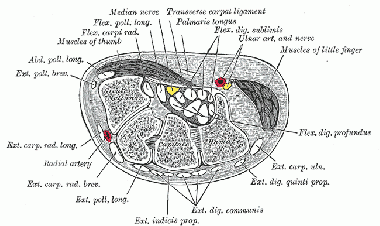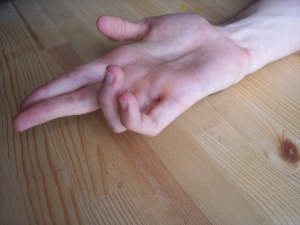Benediction Hand (aka Benediction Sign or Preacher's Hand)
Original Editor -Pamela Gonzalez
Top Contributors - Laura Ritchie, Aminat Abolade, Kirenga Bamurange Liliane, Admin, Kim Jackson, Pamela Gonzalez, Rachael Lowe, David Adamson, WikiSysop, Lauren Kwant, Evan Thomas and Richard Benes
Clinically Relevant Anatomy
[edit | edit source]
The Benediction Sign is the result of a peripheral neuropathy affecting musculature in the hand. According to Futterman, [1] there has been a controversy as to the source Benediction Sign for many years, specifically if the median nerve or the ulnar nerve is involved.
According to Futterman, [1] the desired position of the hand during a blessing or benediction would typically have been an open position with the fingers extended. In fact, he notes that the 4th and 5th digits would have been abducted from the second and third digits (similar to the hand sign used by Vulcans in the Star Trek TV and movie series). [1] Based on this author's research of cultural artwork, he asserts that Peter, the first Pope, had an ulnar neuropathy which limited Peter's ability to perform the then-traditional open hand blessing and has led to the hand position that has since become the norm for giving blessings.[1]
In the presence of an ulnar neuropathy, function of the interossei and lumbrical muscles to the 4th and 5th digits would be compromised, thus the 4th and 5th digits could not abduct from the midline of the hand (interossei function) nor could those fingers flex at the MCP joints or extend at the IP joints (lumbrical function). Extensor digitorum (innervated by the radial nerve) acts primarily on the MCP joint, not the IP joints, therefore it could not extend the IP joints to compensate for loss of lumbrical function. [2] As a result, during an attempt to extend the 4th and 5th digits (as in the open hand blessing described above) the MCP joints be extended but the IP joints would stay flexed.
Futterman [1] notes that Benediction Sign is often described as a median nerve injury because this would result in an inability to perform flexion at the MCP and IP joints of the 2nd and 3rd digits. However, he notes that this would only make sense if the injured person was trying to make a fist and since a fist is not a historically-known sign of blessing or greeting, Benediction Sign must stem from an ulnar neuropathy and the subsequent inability to fully open the hand.
Mechanism of Injury / Pathological Process
[edit | edit source]
Clinical Presentation[edit | edit source]
Diagnostic Procedures[edit | edit source]
add text here relating to diagnostic tests for the condition
Outcome Measures[edit | edit source]
add links to outcome measures here (see Outcome Measures Database)
Management / Interventions
[edit | edit source]
add text here relating to management approaches to the condition
Differential Diagnosis
[edit | edit source]
add text here relating to the differential diagnosis of this condition
Key Evidence[edit | edit source]
add text here relating to key evidence with regards to any of the above headings
Case Studies[edit | edit source]
add links to case studies here (case studies should be added on new pages using the case study template)
Resources
[edit | edit source]
http://teachmeanatomy.info/upper-limb/nerves/ulnar-claw-vs-hand-of-benediction/
Recent Related Research (from Pubmed)[edit | edit source]
Failed to load RSS feed from http://www.ncbi.nlm.nih.gov/entrez/eutils/erss.cgi?rss_guid=1: Error parsing XML for RSSReferences[edit | edit source]








